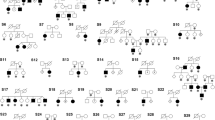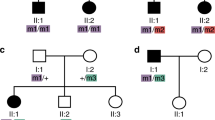Abstract
Autosomal dominant cerebellar ataxia with pigmentary macular dystrophy (ADCA type II) is a rare neurodegenerative disorder with marked anticipation. We have mapped the ADCA type II locus to chromosome 3 by linkage analysis in a genome-wide search and found no evidence for genetic heterogeneity among four families of different geographic origins. Haplotype reconstruction initially restricted the locus to the 33 cM interval flanked by D3S1300 and D3S1276 located at 3p12–p21.1. Combined multipoint analysis, using the Zmax-1 method, further reduced the candidate interval to an 8 cM region around D3S1285. Our results show that ADCA type II is a genetically homogenous disorder, independent of the heterogeneous group of type I cerebellar ataxias.
This is a preview of subscription content, access via your institution
Access options
Subscribe to this journal
Receive 12 print issues and online access
$209.00 per year
only $17.42 per issue
Buy this article
- Purchase on Springer Link
- Instant access to full article PDF
Prices may be subject to local taxes which are calculated during checkout
Similar content being viewed by others
References
Harding, A.E. The clinical features and classification of the late onset autosomal dominant cerebellar ataxias. Brain 105, 1–28 (1982).
Harding, A.E. Clinical features and classification of inherited ataxias. in Advances in Neurology. (eds Harding, A.E., Deufel, P.) Vol 61: Inherited ataxias, 1–14 (Raven Press, 1993).
Konigsmark, B.W. & Weiner, L.P. The olivopontocerebellar atrophies: a review. Medicine 49, 227–241 (1970).
Benomar, A. et al. Autosomal-dominant cerebellar ataxia with retinal degeneration (ADCA type II) is genetically different from ADCA type I. Ann. Neurol. 35, 439–444 (1994).
Martin, J.-J. et al. On an autosomal dominant form of retinal-cerebellar degeneration: an autopsy study of five patients in one family. Acta Neuropathol. 88, 277–286 (1994).
Enevoldson, T.P., Sanders, M.D. & Harding, A.E. Autosomal dominant cerebellar ataxia with pigmentary retinal dystrophy. A clinical and genetic study of eight families. Brain 117, 445–460 (1994).
Gouw, L.G., Digre, K.B., Harris, C.P., Haines, J.H. & Ptacek, L.J. Autosomal dominant cerebellar ataxia with retinal degeneration: Clinical, neuropathologic, and genetic analysis of a large kindred. Neurology 44, 1441–1447 (1994).
Dürr, A. et al. Phenotypic variability in autosomal dominant cerebellar ataxia type I is unrelated to genetic heterogeneity. Brain 116, 1497–1508 (1993).
Orr, H.T. et al. Expansion of an unstable trinucleotide CAG repeat in spinocerebellar ataxia type 1. Nature Genet. 4, 221–226 (1993).
Gispert, S. et al. Chromosomal assignment of the second locus for autosomal dominant cerebellar ataxia (SCA2) to human chromosome 12q23-24.1. Nature Genet. 4, 295–299 (1993).
LaSpada, A.R., Wilson, E.M., Lubahn, D.B., Harding, A.E. & Fishbeck, K.H. Androgen receptor gene mutations in X-linked spinal and bulbar muscle atrophy. Nature 352, 77–79 (1991).
A novel gene containing a trinucleotide repeat that is expanded and unstable on Huntington's disease chromosomes. Cell. 72, 971–983 (1993).
Koide, R. et al. Unstable expansion of CAG repeat in hereditarydentatorubral-pallidoluysian atrophy (DRPLA). Nature Genet. 6, 9–13 (1994).
Nagafuchi, S. et al. Dentatorubral and pallidoluysian atrophy expansion of an unstable CAG trinucleotide on chromosome 12p. Nature Genet. 6, 14–18 (1994).
Kawaguchi, Y. et al. CAG expansions in a novel gene for Machado-Joseph disease at chromosome 14q31.2. Alaftlre Genet. 8, 221–228 (1994).
Farrer, L.A., Cupples, L.A., Kiely, D.K., Conneally, P.M. & Myers, R.H. Inverse relationship between age at onset of Huntington disease and paternal age suggests involvement of genetic impinting. Am. J. hum. Genet. 50, 528–535 (1991).
Dubourg, O. et al. Analysis of the SCA1 CAG repeat in a large number of families with dominant ataxia: clinical and molecular correlations. Ann. Neurol. 37, 176–180 (1995).
Weissenbach, J. et al. A second generation linkage map of the human genome. Nature. 359, 794–801 (1992).
Gyapay, G. et al. The 1993–1994 Généthon human genetic linkage map. Nature Genet. 7, 246–339 (1994).
Stevanin, G. et al. A third locus for autosomal dominant cerebellar ataxia type I maps to chromosome 14q24.3-qter: Evidence for the existence of a fourth locus. Am. J. hum. Genet. 54, 11–20 (1994).
Lathrop, G.M. & Lalouel, J.M. Easy calculations of lod scores and genetic risks on small computers. Am. J. hum. Genet. 36, 460–465 (1984).
Lathrop, G.M., Lalouel, J.M., Julier, C. & Ott, J. Multilocus linkage analysis in humans: detection of linkage and estimation of recombination. Am. J. hum. Genet. 37, 482–498 (1985).
Cottingham, R.W., Idury, R.M. & Schäffer, A.A. Faster sequential genetic linkage computations. Am. J. hum. Genet. 53, 252–263 (1993).
Schäffer, A.A., Gupta, S.K., Shiram, K. & Cottingham, R.W., Avoiding recomputation in genetic linkage analysis. Hum. Heredity. 44, 225–237 (1994).
Ott, J. in Analysis of human Genetic Linkage. 2nd edn 1–302 (Johns Hopkins University Press, Baltimore, 1991).
Conneally, P.M. et al. Report of the committee on methods of linkage analysis and reporting (HGM 8). Cytogenet. cell Genet. 40, 356–359 (1985).
Author information
Authors and Affiliations
Rights and permissions
About this article
Cite this article
Benomar, A., Krols, L., Stevanin, G. et al. The gene for autosomal dominant cerebellar ataxia with pigmentary macular dystrophy maps to chromosome 3p12–p21.1. Nat Genet 10, 84–88 (1995). https://doi.org/10.1038/ng0595-84
Received:
Accepted:
Issue Date:
DOI: https://doi.org/10.1038/ng0595-84
This article is cited by
-
Clinical and genetic spectrums of 413 North African families with inherited retinal dystrophies and optic neuropathies
Orphanet Journal of Rare Diseases (2022)
-
Functional characterization of variants of unknown significance in a spinocerebellar ataxia patient using an unsupervised machine learning pipeline
Human Genome Variation (2022)
-
Longitudinal Analysis of the Relation Between Clinical Impairment and Gray Matter Degeneration in Spinocerebellar Ataxia Type 7 Patients
The Cerebellum (2021)
-
Exploring the Potential of Small Molecule-Based Therapeutic Approaches for Targeting Trinucleotide Repeat Disorders
Molecular Neurobiology (2020)
-
Founder Effects of Spinocerebellar Ataxias in the American Continents and the Caribbean
The Cerebellum (2020)



